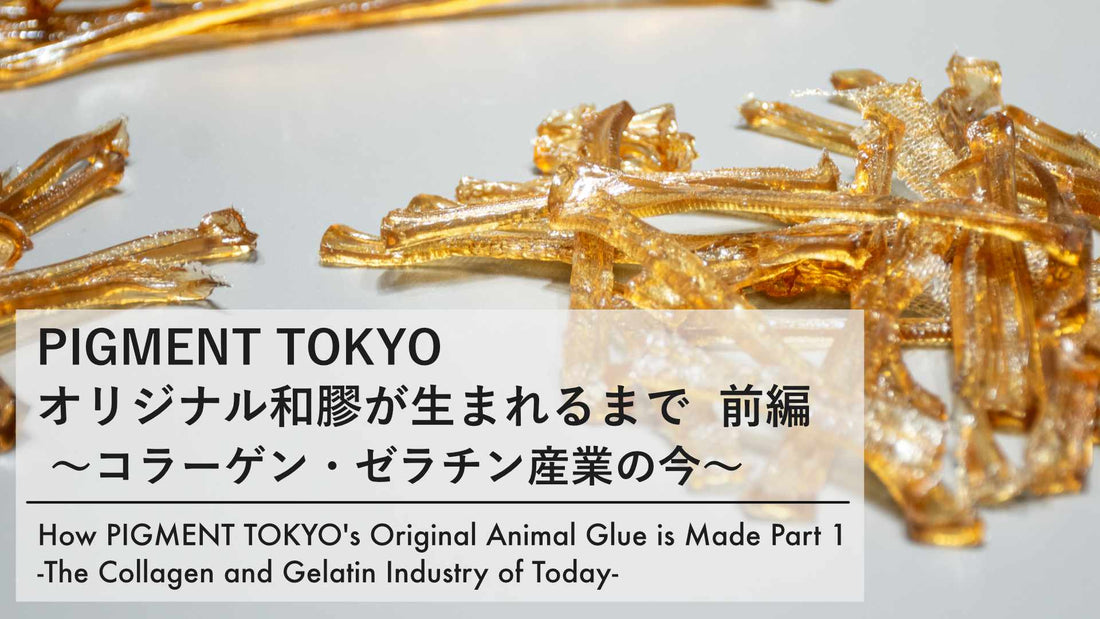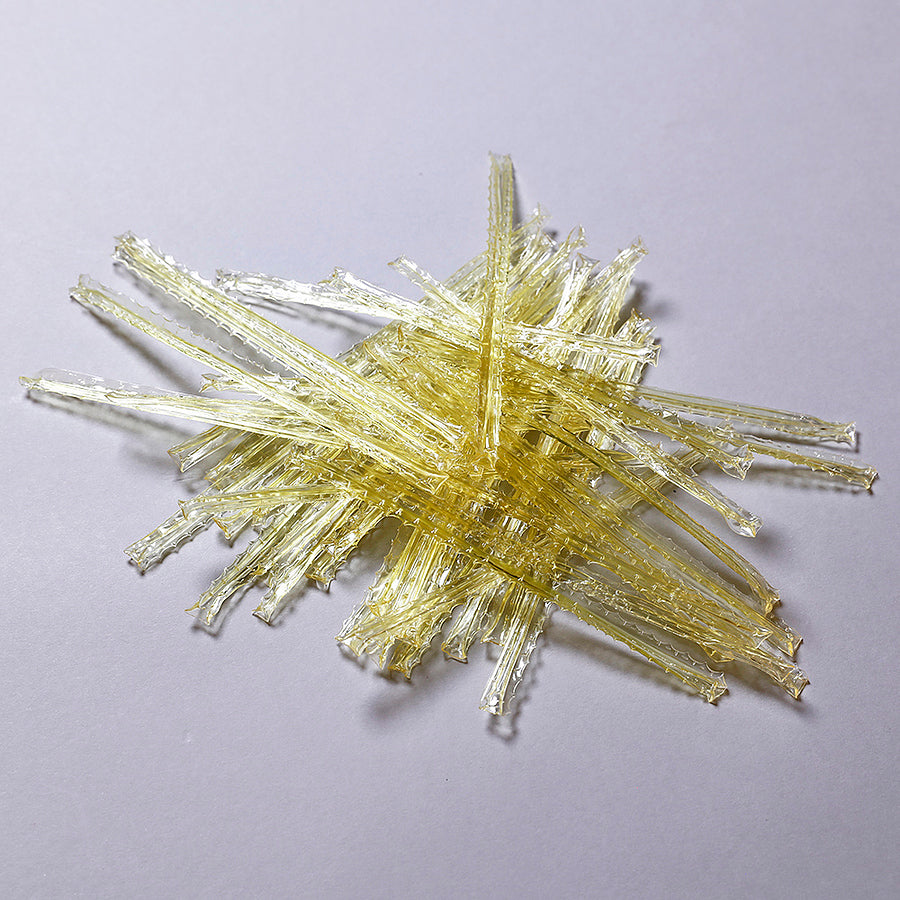Nikawa, also known as “animal glue,” is an essential material for paintings, especially traditional Japanese paintings.
It originated in ancient Egypt and has long been used as an adhesive throughout history.
The use of animal glue in Japan is mentioned in the fifteenth volume of the “和名類聚抄 Wamyō ruijushō,” the oldest existing Chinese-Japanese dictionary for classifying and annotating things. This dictionary was compiled in the Heian period (*1) by the Japanese-Chinese scholar, 源順 Minamoto-no-Shitagou, and transcribed in the later period (*2).
(*1 794-1185)
(*2 Late Muromachi Period, 1566)
PIGMENT TOKYO offers several kinds of original glue.
This includes granulated glue made from cowhide that has characteristics similar to Japanese animal glue.
We provide ox glue solutions made from granulated glue using an original recipe, as well as animal glue for dosa sizing that does not contain alum.
Moreover, PIGMENT TOKYO also carries rare animal glues that are difficult to find in other art supply stores.
For more information, please check the following link.
Furthermore, we also offer products for professionals, such as cow-based Japanese glue, which is handcrafted from a single batch of dried cow skin that was previously used for drum leather; and fish-based Japanese glue also made by hand from a single lot of fish skin. (Please note that the physical properties of these products may vary depending on the specific lot.)
All these animal glues are produced by KOEI CHEMICAL CO., LTD. which is a manufacturer of gelatin and collagen peptides in Himeji City, Hyogo Prefecture.
Himeji City is known as the birthplace of hide tanning in Japan, and about 25% of gelatin, 50% of collagen peptide and 100% of animal glue available in Japan are produced in Hyogo Prefecture.

This time, we visited Himeji City to interview Takashi Fukushima, the CEO of KOEI CHEMICAL CO., LTD. Our discussion focused on animal glue, its current market conditions and the company's products.
We also explored how they have adapted to changes in the industry, especially in a region with a long-established leather and gelatin sector.
ーFirst of all, may I ask you about KOEI CHEMICAL CO., LTD.? What kind of products do you make?
Takashi Fukushima (hereinafter “Fukushima” / titles omitted): We were founded in 1938 and started manufacturing “Aboshi-Nikawa*.” We began producing Western-style animal glue in 1958 and then gelatin in 1978.
Later, we commercialized collagen peptides in 2003, and now we mainly focus on making collagen peptides and gelatin. Our products are mostly used in health food products and food additives.
*Aboshi is located in Himeji City and is famous for producing Nikawa (animal glue).

CEO of KOEI CHEMICAL CO., LTD, Takashi Fukushima (right) sharing his story with us, and Takuya Fukushima (left) is the manager of the marketing department.
ーWhen I visited your website, I saw you are offering many different products. How many types of raw materials do you handle for manufacturing animal glue?
Fukushima: We have tried more than ten types of raw materials, including cows, pigs, wild boar, deer, cod fish, sea bream, catfish, whale and many others that did not make it to a commercial product.

ーWhat is the dividing line between animal glue, collagen glue and collagen peptides?
Fukushima: At first, we can categorize these substances based on their solubility in water and whether they solidify or remain liquid when chilled.
For example, collagen, the raw material for all products, is insoluble in water at room temperature, but when heated, it transforms into a water-soluble protein known as gelatin or animal glue.
The key characteristic of these products is that they dissolve upon heating and solidify when chilled. This process is called solidification or gelation, and the reversible nature is utilized in various applications.
Collagen peptides are made by breaking down gelatin with enzymes. Collagen peptides have a smaller molecular weight than gelatin and are soluble in water but do not harden when chilled like gelatin. For this reason, collagen peptides are often used in supplements and drinking water.

ー How is the animal glue used for painting categorized among these products?
Fukushima: Animal glue labelled as an art material only occupies a small segment of the market. Therefore, it is likely categorized under "others."
We manufacture this product on a small scale, primarily wholesaling to PIGMENT TOKYO. As for animal glue in general, we import and sell it for the abrasives.

ーCould you tell us the difference between gelatin and animal glue?
Fukushima: Gelatin is highly refined and animal glue is less refined.
In 2000, we stopped handling shaving materials to manufacture edible gelatin and collagen peptides. In 2009, we also discontinued the production of industrial gelatin from subcutis and now produce only edible gelatin and collagen peptides.

Shaving material is a byproduct of the manufacture of chrome-tanned leather. The leftover after shaving to obtain a smooth surface was used as a raw material for industrial glue.
ーIf that’s the case, the granulated ox glue that PIGMENT TOKYO carries can also be......
Fukushima: Edible gelatin is specially processed for art and painting materials.*
(*Please note that all PIGMENT TOKYO products are manufactured and sold for painting use and should not be ingested.)
ーWhat are gelatin and glue used for today?
Fukushima: The most recent application of gelatin is in the production of gummies. Other than that, it is also used in the fields of functional food and regenerative medicine.
In terms of adhesive uses, gelatin can be found in matches, abrasive cloth paper, paper containers, paper tubes, bookbinding, etc.
However, the animal glue market has been declining since 1996. This is due to the increasing use of lighters, the shift from paper containers to cardboard boxes and the decreasing number of hardcover books.
Animal glue is known for its immediate strong bonding power and high viscosity, which allows it to gel right after application. These unique characteristics make it particularly suitable for the production of paper boxes.
ーHave there been any major changes in the leather or the gelatin/animal glue industries over the past few years?
Fukushima: Generally, the leather industry is associated with companies that produce leather from adult cows and pigs. While this is related to our industry, it is a distinct field.
In Hyogo Prefecture, specific areas such as Takagi, Mitsugi, and Aboshi in Himeji City, as well as Matsubara, Eida, and Sawada in Tatsuno City, along with Taishi-cho, account for about half of the companies and shipments in Japan. They hold approximately 70% of the national market share in the production of adult cowhide.
Furthermore, the slowdown in the leather industry has significantly impacted our company, as our main raw material is a byproduct of this industry. At the same time, the shift towards high-value-added products such as gelatin and collagen peptides has led to domestic glutinous products primarily being "industrial gelatin," which is manufactured from raw materials that cannot be converted into food products. The Himeji area is the only region in Japan that manufactures this type of industrial gelatin from those raw materials.
ーMay I ask how you got involved in KOEI CHEMICAL’s original animal glue production?
Fukushima: Our handmade animal glue began in February 2014, when Professor Yoshiaki Aoki, who teaches the Kyoto Painting Technique & Materials Study Group at Kyoto University of Art and Design (formerly Kyoto University of Art and Design), requested us to hold a workshop for his students.
However, the workshop has since concluded, and currently, we are only manufacturing for PIGMENT TOKYO.
ーWhat kind of raw materials are used for PIGMENT TOKYO's original animal glue?
Fukushima: We use raw materials that can produce suitable properties for painting and the entire process of making animal glue, from fire-making to drying, is performed by our staff by hand. Therefore, it is not easy to manufacture in large quantities.
This is the reason why each product is sold with different physical properties.
 The display of animal glue in PIGMENT TOKYO. As mentioned above, each has different physical properties.
The display of animal glue in PIGMENT TOKYO. As mentioned above, each has different physical properties.
ーHow are they manufactured?
Fukushima: We manufacture in an area where quality is measured and tested.
We sell our products with confidence that our manufacturing department staff can produce high-quality animal glue.

The laboratory in KOEI CHEMICAL CO., LTD.
Carefully manufactured and delivered to PIGMENT TOKYO.
Although I had assumed that “only glue made by boiling animal skins as raw materials is animal glue,” the gelatin and glue industry has diversified its raw materials and manufacturing methods by changing times and needs.
In recent years, the company has received more inquiries about gelatinization and collagen peptide conversion from animal by-products from the perspective of sustainable development goals.
This interview made me feel the hidden potential of animal glue-making technology. Animal glue is familiar to us artists, but its technology has contributed to the cutting-edge medical field while making efficient use of limited resources.
In the second part of the article, I will introduce the actual manufacturing process from the raw materials of our original animal glue.
【PIGMENT ARTICLES】
How PIGMENT TOKYO's Original Animal Glue is Made—Behind the Scenes of Manufacturing Made-in-Japan Animal Glue—Part 2
【Corporate Information】
KOEI CHEMICAL CO., LTD
33 Yobe-ku Kamiyobe, Himeji-shi, Hyogo,671-1262 Japan
CEO: Takashi Fukushima
TEL:079-273-2001
FAX:079-273-2010
WEB:https://www.koei-chem.com/index.html
*Animal glue manufactured by this company is exclusive to PIGMENT TOKYO's products.
You may purchase them through PIGMENT TOKYO physical and online stores.
https://pigment.tokyo/en
【References】
National Institute for Japanese Language and Linguistics, “Textual Data Collection for the Study of the History of the Japanese Language: Twenty Volume Book of Wamyō ruijushō [Early movable type printing]” (viewed March 1, 2024).
https://www2.ninjal.ac.jp/textdb_dataset/en/kwrs/kwrs-015.html
Gelatin Manufactures Association of Japan, "What is Gelatin?" (viewed March 1, 2024)
https://www.gmj.or.jp/gelatin/introduction.html
Gelatin Manufactures Association of Japan, “Collagen Peptide” (viewed March 1, 2024)
https://www.gmj.or.jp/collagen/collagen-peptide.html
Hyogo Leather Industry Cooperative Union (Hyohiren), “History of Leather in Hyogo” (viewed March 1, 2024)
https://www.hyohiren.or.jp/HISTORY.html
Hyogo Prefecture, “Introduction of Local Industries in Hyogo” (viewed March 1, 2024)
https://web.pref.hyogo.lg.jp/fl/index.html
Cultural Heritage Online, “Wamyoruijusho” (viewed March 1, 2024)
https://bunka.nii.ac.jp/heritages/detail/90530
PIGMENT TOKYO Art Materials Experts



